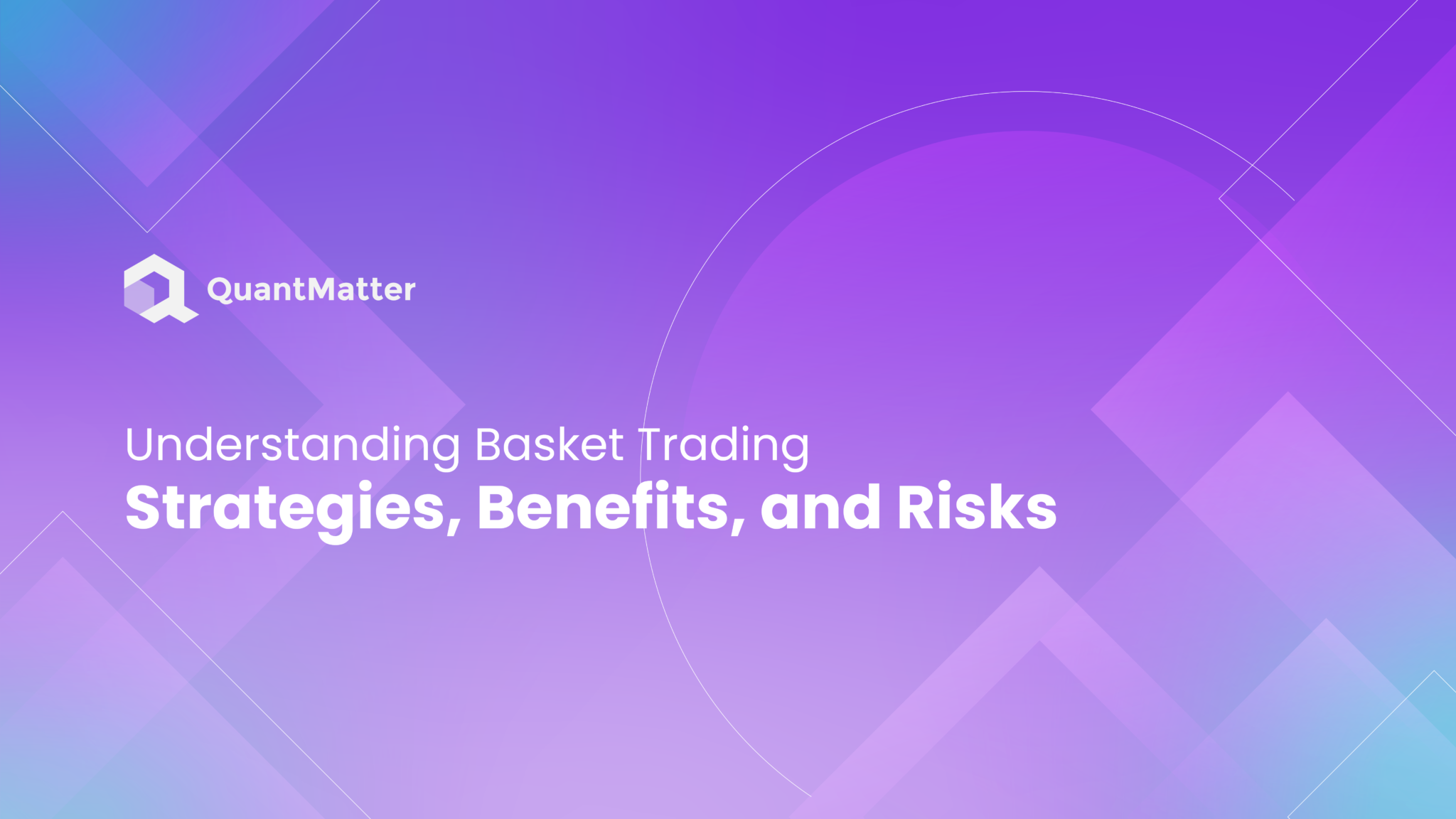
Basket trading is an intricate and versatile investment strategy that has gained prominence in the world of professional traders and institutional investors. This sophisticated approach involves trading a collection of financial assets as a single, unified entity, commonly referred to as a “basket.”
In this comprehensive exploration, we will delve into the multifaceted world of basket trading, including its definition, operational mechanics, a spectrum of potential advantages, and the intricacies of managing associated risks. We will also elucidate various strategies employed in basket trading and provide insights into their practical implementation. This in-depth analysis aims to equip both novice and experienced investors with a profound understanding of basket trading and its role in contemporary financial markets.
What is Basket Trading?

Basket trading has undergone significant evolution, with its development intricately intertwined with technological advancements and financial innovation. While its roots can be traced back to the early days of stock markets, where traders assembled collections of stocks to create diversified portfolios, modern basket trading has been fundamentally reshaped by several key factors.
- Electronic Trading Platforms
One of the pivotal transformations in basket trading has been the widespread adoption of electronic trading platforms. These platforms have revolutionized how traders create, manage, and execute basket trades. They provide access to real-time pricing information, sophisticated order routing capabilities, and a plethora of tools that streamline the entire trading process. Electronic platforms have become the cornerstone of efficient basket trading, enabling traders to access global markets with ease.
- Algorithmic Trading
Within the realm of basket trading, algorithmic trading has emerged as a driving force. Algorithms can be programmed to execute basket trades automatically based on predefined criteria. These criteria can encompass factors such as asset allocation, risk tolerance, or real-time market conditions. Algorithmic trading not only reduces the potential for human error but also empowers traders to execute complex trading strategies with unparalleled speed and precision. This level of automation has become indispensable for managing basket portfolios efficiently.
- Diverse Asset Inclusion
In the modern landscape, basket trading has expanded far beyond its origins. Traditionally centered on equities, today’s basket portfolios can encompass a diverse range of assets, including bonds, commodities, currencies, exchange-traded funds (ETFs), and more. This expanded toolkit provides traders and investors with unprecedented flexibility, allowing them to craft portfolios that are finely tuned to their specific investment objectives. Whether seeking income, capital preservation, or growth, the ability to diversify across various asset classes is a key advantage.
- Global Reach
The globalization of financial markets has also played a pivotal role in the evolution of basket trading. Traders now have access to a broad spectrum of international markets and assets. This global reach not only enhances diversification but also allows investors to capitalize on opportunities and mitigate risks across borders.
- Risk Management Tools
Basket trading has benefited from the development of advanced risk management tools and analytics. These tools enable traders to assess the risk associated with their portfolios comprehensively. Through scenario analysis, stress testing, and other risk assessment techniques, investors can make informed decisions to protect their portfolios and navigate turbulent market conditions.
Basket trading continues to evolve, adapt, and remain a valuable tool for traders and investors alike. It offers a versatile and sophisticated approach to portfolio management, enabling market participants to optimize their investment strategies in response to changing market dynamics and the pursuit of specific financial goals. As technology and innovation continue to shape the financial industry, basket trading remains at the forefront of modern investment strategies.
How Does Basket Trading Work?

Asset Selection
The foundation of basket trading is the meticulous and strategic selection of assets to be included within the basket. This critical step hinges on the trader’s or investor’s specific objectives, which can span a broad spectrum of considerations. These considerations may include diversification across sectors, geographic regions, or asset classes to spread risk effectively. Additionally, asset selection may aim to provide exposure to specific industries or investment themes aligned with the trader’s overarching strategy.
Weighting Allocation
Once the assets are carefully chosen, the next step is to assign a specific weight or allocation percentage to each asset within the basket. This allocation determines the proportion of the portfolio’s capital allocated to each constituent asset. The choice of how to allocate these weights can be highly strategic, and traders often have various methods at their disposal.
These methods include uniform weighting, where each asset receives an equal share of the allocation, or market-capitalization-based weighting, which assigns higher allocations to assets with larger market capitalizations. Furthermore, other factors such as historical performance, volatility, or fundamental metrics can influence allocation decisions, aligning them with the trader’s unique investment approach.
Order Execution
After defining the basket’s composition and allocation percentages, traders execute a single order to buy or sell the entire basket. This process is executed with precision and efficiency, often leveraging advanced trading technologies and algorithms. These cutting-edge tools help streamline the order execution process, ensuring minimal slippage and reducing overall execution costs. The use of technology also enables traders to take advantage of market opportunities swiftly and effectively.
Also Read: All About Algorithmic Trading That You Should Know!
Rebalancing
As time progresses, the performance of individual assets within the basket may deviate from their initial allocations. This natural variation can occur due to market dynamics, economic changes, or shifts in investor sentiment. To maintain the desired portfolio balance and align it with their investment goals, traders engage in periodic rebalancing. This entails adjusting the weightings of individual assets within the basket. Rebalancing can involve selling overperforming assets to capture profits and allocating more resources to underperforming assets to take advantage of potential future gains. This disciplined approach helps traders stay on course with their long-term objectives and adapt to evolving market conditions.
Successful basket trading involves a series of carefully considered steps, from the initial asset selection based on specific objectives through precise allocation of weights and efficient order execution to regular rebalancing to ensure portfolio alignment with strategic goals. By following this comprehensive approach, traders and investors can effectively manage risk, capture opportunities, and optimize their investment portfolios over time.
Benefits of Basket Trading

Basket trading is a versatile investment strategy that has gained popularity among traders and investors due to the multitude of benefits it offers, ranging from diversification to customization. Let’s delve deeper into these advantages:
– Diversification
Diversification is the cornerstone of basket trading, underpinning its success as an investment strategy. At its core, diversification empowers investors to spread risk across a wide array of assets. Rather than trading individual securities, investors create a portfolio of assets within a single basket. This approach significantly reduces exposure to the fluctuations of any single asset, enhancing risk management. The diversification achieved in basket trading extends across sectors, industries, geographic regions, and asset classes, creating a resilient and robust portfolio. By diminishing the impact of poor performance in one asset, diversification not only mitigates risk but also augments the potential for consistent returns.
– Efficiency
Efficiency is a pivotal benefit of basket trading. This strategy streamlines the trading process by consolidating multiple orders into a single, comprehensive order for the entire basket. This not only saves valuable time but also results in substantial reductions in transaction costs, including commissions and fees. Institutional investors and traders handling large, complex portfolios find these efficiency gains particularly advantageous, as they simplify management and reduce the risk of errors. Moreover, the streamlined trading process minimizes the likelihood of missed opportunities or delayed execution, enabling swift responses to changing market dynamics.
– Cost Savings
The potential for cost savings in basket trading is significant. Beyond commission and fee reductions, this approach minimizes the need for multiple order placements, thereby reducing costs associated with bid-ask spreads and market impact. These savings can be especially impactful for investors overseeing extensive portfolios. By cutting down on transaction costs, basket trading maximizes the efficiency of capital allocation and preserves more of the returns generated by the portfolio.
Also Read: Market Maker Options: Definition and How They Make Money
– Customization
Basket trading empowers investors with a high degree of customization. Traders can craft baskets tailored precisely to their unique investment objectives, risk tolerance, and market outlook. This adaptability facilitates the implementation of a wide range of strategies, from passive indexing to active trading based on specific criteria or investment themes. Whether seeking income generation, capital preservation, or aggressive growth, basket trading offers a versatile platform for strategy execution.
Customization extends to various aspects of trading, including asset selection, allocation percentages, and the criteria used to determine basket composition. Passive investors may opt for baskets replicating specific market indices or benchmarks, while active traders can design baskets around technical or fundamental criteria. This flexibility enables investors to remain agile in response to changing market conditions and evolving financial goals.
Basket trading presents a wealth of benefits, from diversification and efficiency to cost savings and customization. This investment strategy caters to investors across a spectrum of risk appetites and investment objectives. By harnessing these advantages, investors can navigate the complexities of modern financial markets with enhanced confidence, efficiency, and resilience.
Risks of Basket Trading
– Tracking Error
One of the important considerations in basket trading is the tracking error, which refers to the potential deviation in the performance of the basket from that of its underlying assets. This discrepancy can arise due to various factors, including execution slippage, transaction fees, and the timing of rebalancing. Execution slippage occurs when the actual execution price differs from the expected price, leading to variations in returns. Additionally, transaction fees incurred during the trading process can reduce overall returns. Furthermore, the timing of rebalancing, especially in volatile markets, can lead to differences in asset allocations, contributing to tracking errors. It’s essential for traders and investors to closely monitor and manage tracking errors to ensure the basket’s performance aligns with their investment objectives.
– Liquidity Risk
Another critical consideration in basket trading is liquidity risk. This risk arises from disparities in liquidity levels among the assets within the basket. Some assets may be highly liquid, easily tradable, and have minimal impact on prices when large orders are executed. However, less liquid assets within the basket may pose challenges. Executing large orders for these assets can result in price slippage, where the purchase or sale of a significant quantity of the asset affects its market price. This liquidity risk underscores the importance of carefully managing trade execution to mitigate adverse price impacts and minimize trading costs.
– Complexity
Managing a portfolio composed of multiple assets introduces a layer of complexity. The intricate nature of basket trading requires ongoing monitoring and periodic rebalancing, which demand careful attention and expertise. Traders and investors must consider factors such as asset performance, market conditions, and evolving investment goals to make informed decisions. Additionally, the choice of rebalancing strategies, whether based on predetermined criteria or market conditions, adds to the complexity of managing a basket portfolio. Properly navigating this complexity is crucial to achieving the desired investment outcomes.
– Market Risk
Despite the benefits of diversification, basket trading does not eliminate market risk entirely. While diversifying across multiple assets can help mitigate individual asset risk, the portfolio remains exposed to overall market risk. Systemic shocks, macroeconomic events, or market downturns can impact all assets within the basket simultaneously. It’s essential for traders and investors to be aware of this inherent market risk and have risk management strategies in place to protect their portfolios during turbulent market conditions. Effective risk management can include diversifying across different asset classes or employing hedging strategies to reduce overall portfolio vulnerability.
Basket trading involves navigating various challenges, including tracking errors arising from execution slippage and fees, liquidity risk due to varying asset liquidity levels, the complexity of managing multiple assets, and the persistence of market risk despite diversification efforts. Acknowledging and effectively addressing these challenges is crucial for achieving successful and resilient basket trading strategies. By doing so, traders and investors can better position themselves to meet their financial objectives and adapt to changing market dynamics.
Conclusion
Basket trading represents a potent investment strategy offering diversification, efficiency, and customization. Nevertheless, successful implementation requires careful planning and management to mitigate associated risks. Staying informed about market conditions and the performance of basket constituents is paramount for making informed decisions when managing basket portfolios. Basket trading is a versatile and sophisticated approach that can be harnessed by both professional traders and institutional investors to achieve a wide array of financial objectives.
Basket trading embodies the essence of modern portfolio management, providing a pathway to constructing diversified, efficient, and customizable portfolios. By capitalizing on its strengths and actively managing its risks, investors and traders can harness the full potential of basket trading to achieve a wide array of financial objectives. Whether you are an experienced professional or a novice investor, basket trading offers a sophisticated yet accessible approach to realizing your investment goals in today’s intricate financial world.
Disclaimer: The information provided by Quant Matter in this article is intended for general informational purposes and does not reflect the company’s opinion. It is not intended as investment advice or a recommendation. Readers are strongly advised to conduct their own thorough research and consult with a qualified financial advisor before making any financial decisions.
I craft stories that make complex ideas clear. I simplify the blend of data science, machine learning, and crypto trading, showcasing how advanced tech and quantitative models analyze data for informed trading choices. Join me in exploring the realm of quantitative trading, where my narratives make intricate concepts easy to grasp.
-
Alifia Berizkyhttps://quantmatter.com/author/alifia-berizky/
-
Alifia Berizkyhttps://quantmatter.com/author/alifia-berizky/
-
Alifia Berizkyhttps://quantmatter.com/author/alifia-berizky/
-
Alifia Berizkyhttps://quantmatter.com/author/alifia-berizky/

